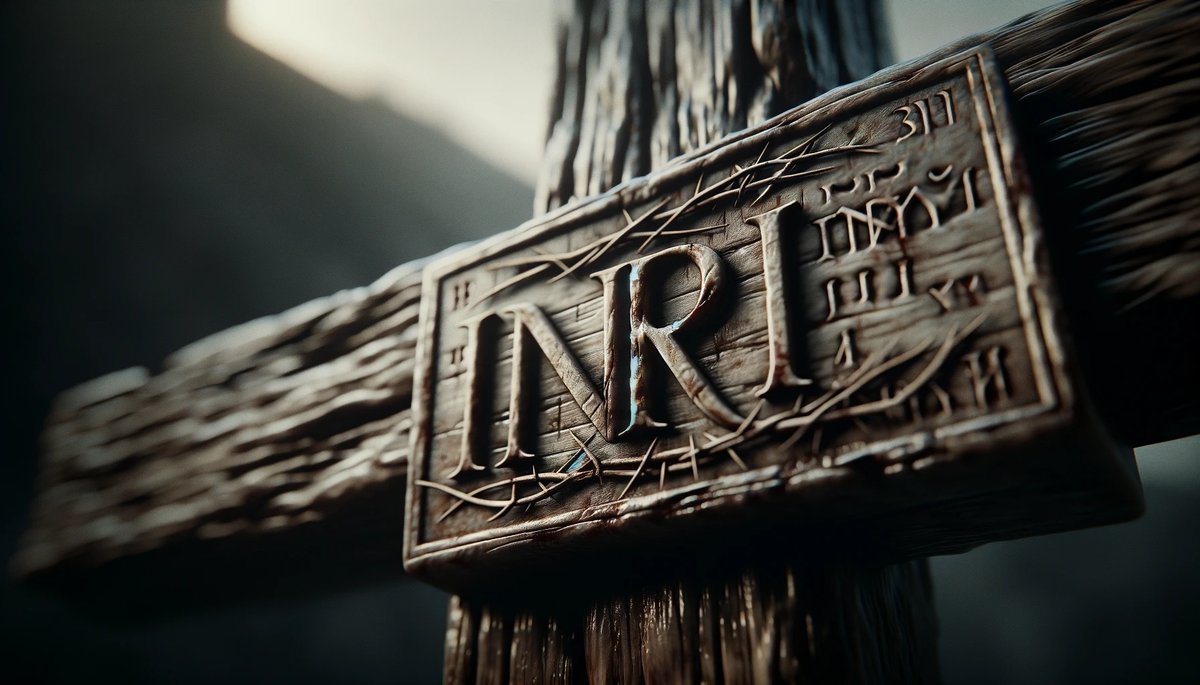Home>Theology and Spirituality>Why Is The Sign Of The Cross Used In Baptism


Theology and Spirituality
Why Is The Sign Of The Cross Used In Baptism
Published: February 26, 2024
Peter Smith, Editorial Director at Christian.net, combines deep insights into faith, politics, and culture to lead content creation that resonates widely. Awarded for his contributions to religious discourse, he previously headed a major organization for religious communicators, enhancing dialogue on faith's societal impacts.
Discover the significance of the sign of the cross in baptism and its role in theology and spirituality. Explore its deep-rooted symbolism and spiritual implications.
(Many of the links in this article redirect to a specific reviewed product. Your purchase of these products through affiliate links helps to generate commission for Christian.net, at no extra cost. Learn more)
Table of Contents
Introduction
Why is the sign of the cross used in baptism? The sign of the cross is a significant ritual in many Christian denominations, particularly during the sacrament of baptism. It holds deep historical and symbolic meanings that are integral to the baptismal rite. In this article, we will explore the historical origins, symbolism, and role of the sign of the cross in baptism, as well as its significance in different Christian traditions. Understanding the use of the sign of the cross in baptism provides insight into the rich tapestry of religious practices and beliefs within Christianity.
Read more: How To Make Sign Of The Cross Lutheran
Historical Origins of the Sign of the Cross in Baptism
-
Early Christian Practices: The use of the sign of the cross in baptism can be traced back to the early Christian church. Early Christians adopted the sign of the cross as a symbol of their faith and as a way to invoke divine protection and blessings. The act of making the sign of the cross over oneself was seen as a way to mark oneself as a follower of Christ and seek the intercession of the Holy Trinity.
-
Biblical References: While the specific practice of making the sign of the cross may not be explicitly mentioned in the Bible, the concept of marking oneself for divine protection and as a sign of faith can be found in passages such as Ezekiel 9:4 and Revelation 7:3. These references may have influenced the early Christians in adopting the sign of the cross as a ritual practice, particularly in the context of baptism.
-
Influence of Early Church Fathers: The writings of early church fathers, such as Tertullian and Cyril of Jerusalem, provide evidence of the use of the sign of the cross in baptismal practices. These influential figures in early Christianity emphasized the significance of the sign of the cross as a symbol of faith and a means of invoking the power of Christ in the sacrament of baptism.
-
Cultural and Symbolic Adaptations: As Christianity spread to different regions, the use of the sign of the cross in baptism also underwent cultural and symbolic adaptations. For example, in the Eastern Orthodox tradition, the sign of the cross is made with two fingers and accompanied by specific prayers during the baptismal rite, reflecting the unique cultural and theological expressions of the faith.
-
Continued Tradition: Over the centuries, the use of the sign of the cross in baptism has remained a consistent and integral part of the sacramental practice in various Christian traditions. The historical origins of this ritual act have contributed to its enduring significance in the life of the Church, serving as a visible and tangible expression of faith and devotion for believers undergoing the sacrament of baptism.
Symbolism and Meaning of the Sign of the Cross in Baptism
The sign of the cross in baptism carries profound symbolism and meaning that enriches the sacramental experience for both the individual being baptized and the faith community. Here are the key aspects of its symbolism and meaning:
-
Triune God: The sign of the cross symbolizes the belief in the Triune God – the Father, the Son, and the Holy Spirit. By making the sign of the cross, the individual being baptized acknowledges their faith in the three persons of the Trinity, affirming their commitment to the Christian belief in the one God in three divine persons.
-
Redemption and Salvation: The act of tracing the cross over oneself during baptism signifies the redemptive work of Jesus Christ on the cross. It serves as a reminder of Christ's sacrifice and the promise of salvation through His death and resurrection. The individual being baptized embraces the transformative power of Christ's redemption as they make the sign of the cross.
-
Protection and Blessing: Making the sign of the cross is also a gesture of seeking divine protection and blessings. It is an expression of trust in God's providence and a plea for His grace to accompany the baptized person throughout their life's journey. The sign of the cross serves as a visible invocation of God's loving care and safeguarding presence.
-
Identity and Commitment: In the context of baptism, the sign of the cross signifies the individual's identity as a Christian and their commitment to living out the teachings of Jesus Christ. It marks the beginning of their life within the Christian community and serves as a visible declaration of their allegiance to the Christian faith.
-
Sealing with the Spirit: Within some Christian traditions, the sign of the cross is associated with the sealing of the baptized person with the Holy Spirit. It represents the outpouring of the Spirit's gifts and graces upon the individual, empowering them to live a life guided by the Spirit and to bear witness to the Christian faith.
-
Continuity of Tradition: The use of the sign of the cross in baptism also reflects the continuity of tradition within the Christian community. It connects the newly baptized with generations of believers who have gone before them, emphasizing the timeless nature of the Christian faith and the enduring significance of its rituals.
The symbolism and meaning of the sign of the cross in baptism encompass a rich tapestry of theological, spiritual, and communal significance, underscoring its integral role in the sacramental life of the Church.
The Role of the Sign of the Cross in the Baptismal Rite
The sign of the cross plays a pivotal role in the baptismal rite, serving as a profound and multifaceted symbol of initiation, faith, and spiritual transformation. Its significance can be observed in various aspects of the baptismal ceremony:
-
Initiation and Welcoming: As the baptismal rite commences, the celebrant or officiant often begins by making the sign of the cross over the water in the baptismal font. This act consecrates the water, signifying its transformation into a sacred element for the sacrament of baptism. The sign of the cross over the water also symbolizes the welcoming of the individual into the Christian community, marking the beginning of their journey of faith.
-
Invocation of the Holy Trinity: When the sign of the cross is made over the individual being baptized, it serves as an invocation of the Holy Trinity – the Father, the Son, and the Holy Spirit. The celebrant traces the cross on the forehead of the baptized person, affirming their incorporation into the life of the Triune God and their participation in the divine life of the Christian community.
-
Sealing with the Sign of Christ: The act of making the sign of the cross on the forehead of the baptized person also signifies their sealing with the sign of Christ. It is a visible and tangible expression of their belonging to Christ and their identification with His redemptive work. The sign of the cross becomes a mark of ownership by Christ, signifying the baptized person's new identity as a member of the body of Christ.
-
Renunciation of Evil and Affirmation of Faith: In some Christian traditions, the baptismal rite includes a specific moment where the individual being baptized, or their sponsors and the faith community, renounce evil and profess their faith. The sign of the cross may be made at this juncture, symbolizing the rejection of sin and the affirmation of the Christian faith. It underscores the transformative nature of baptism as a sacrament of conversion and spiritual rebirth.
-
Blessing and Anointing: Following the baptismal immersion or the pouring of water, the celebrant may make the sign of the cross on the forehead of the baptized person, accompanied by a prayer of blessing. This act symbolizes the bestowal of God's grace and the anointing of the newly baptized with the Holy Spirit. It marks the beginning of their life as a Christian, empowered by the Spirit to live out their baptismal promises.
-
Continued Significance in the Christian Life: Beyond the immediate context of the baptismal rite, the sign of the cross continues to hold significance in the life of the baptized individual. It becomes a daily reminder of their baptismal commitment, a source of strength in times of trial, and a symbol of hope in the journey of faith.
The role of the sign of the cross in the baptismal rite encompasses a rich tapestry of spiritual, communal, and sacramental meanings, underscoring its centrality in the initiation and incorporation of individuals into the Christian faith.
The Sign of the Cross in Different Christian Traditions
The use of the sign of the cross in baptism varies across different Christian traditions, reflecting diverse theological emphases, cultural expressions, and liturgical practices. While the fundamental gesture of making the sign of the cross remains consistent, the specific manner and context in which it is employed exhibit notable distinctions among various Christian denominations. Here are insights into the significance of the sign of the cross in different Christian traditions:
Read more: What Are The Outward Signs Of Baptism
Roman Catholic Tradition
In the Roman Catholic tradition, the sign of the cross holds profound significance in the sacrament of baptism. The celebrant or officiant typically makes the sign of the cross over the individual being baptized at key moments in the rite, such as during the invocation of the Holy Trinity, the anointing with chrism, and the blessing of the newly baptized. The sign of the cross is also integrated into the liturgical prayers and gestures, emphasizing its centrality in the sacramental experience of baptism within the Roman Catholic Church.
Eastern Orthodox Tradition
Within the Eastern Orthodox tradition, the sign of the cross is made with a distinctive gesture using two fingers, symbolizing the dual nature of Christ as fully divine and fully human. In the context of baptism, the sign of the cross is accompanied by specific prayers and ritual actions, reflecting the rich theological and liturgical heritage of the Eastern Orthodox Church. The use of the sign of the cross in baptism underscores the unique spiritual and cultural expressions within Eastern Orthodox Christian communities.
Anglican/Episcopal Tradition
In the Anglican/Episcopal tradition, the sign of the cross is employed in the sacrament of baptism as a visible and symbolic act of initiation into the Christian faith. The celebrant may make the sign of the cross over the individual being baptized, signifying their incorporation into the life of Christ and the community of believers. The Anglican/Episcopal approach to the sign of the cross in baptism reflects a balance of liturgical reverence and pastoral care, affirming the sacramental grace conferred through the ritual.
Lutheran Tradition
In the Lutheran tradition, the sign of the cross is often used in the context of baptism as a tangible expression of God's grace and the individual's identification with Christ. While the specific practices may vary among different Lutheran denominations, the sign of the cross serves as a visible reminder of the redemptive work of Christ and the believer's participation in His saving grace. The Lutheran approach to the sign of the cross in baptism reflects a theological emphasis on the centrality of Christ's atoning sacrifice and the believer's union with Him through faith.
Read more: What Does The Cross Mean In Baptism
Baptist Tradition
In the Baptist tradition, the use of the sign of the cross in baptism is less prevalent, as Baptists emphasize believer's baptism by immersion as a public declaration of faith in Jesus Christ. While the sign of the cross may not be a formal part of the baptismal rite in many Baptist churches, the act of immersion itself symbolizes the death, burial, and resurrection of Christ, embodying the believer's identification with Christ's redemptive work. The Baptist approach to baptism underscores the symbolic significance of immersion as a testimony of faith in Christ.
Pentecostal/Charismatic Tradition
Within Pentecostal and Charismatic Christian traditions, the sign of the cross may be employed in the context of baptism as a personal expression of faith and spiritual empowerment. While practices may vary among different Pentecostal and Charismatic congregations, the sign of the cross can serve as a symbol of consecration, blessing, and the believer's identification with the crucified and risen Christ. The Pentecostal/Charismatic approach to the sign of the cross in baptism reflects an emphasis on the transformative work of the Holy Spirit and the believer's experiential encounter with God's grace.
The diverse expressions of the sign of the cross in baptism across different Christian traditions highlight the richness and diversity of theological perspectives, liturgical practices, and spiritual emphases within the broader tapestry of the Christian faith. While the specific rituals and gestures may vary, the underlying significance of the sign of the cross as a symbol of faith, initiation, and spiritual transformation remains a unifying thread that connects believers across diverse Christian traditions.
Conclusion
The use of the sign of the cross in baptism is deeply rooted in the historical, theological, and ritual tapestry of Christianity. From its early origins in the practices of the early Christian church to its diverse expressions in different Christian traditions, the sign of the cross holds profound significance as a symbol of faith, initiation, and spiritual transformation. Its rich symbolism, encompassing the belief in the Triune God, the redemptive work of Christ, and the invocation of divine blessings, underscores its integral role in the sacrament of baptism. The sign of the cross serves as a visible and tangible expression of the individual's commitment to the Christian faith and their incorporation into the life of the Christian community. Across various Christian denominations, the use of the sign of the cross in baptism reflects the diverse theological emphases, cultural expressions, and liturgical practices within the broader Christian tradition. Understanding the historical origins, symbolism, and role of the sign of the cross in baptism provides valuable insights into the multifaceted nature of religious practices and beliefs within Christianity, enriching the sacramental experience for believers and fostering a deeper appreciation for the spiritual heritage of the Christian faith.













